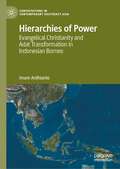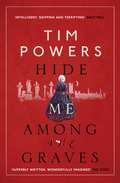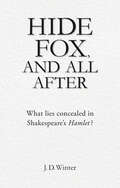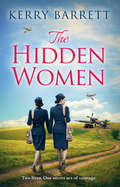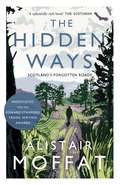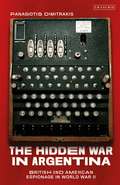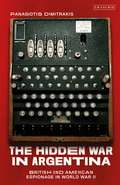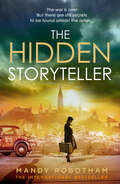- Table View
- List View
The Hieroglyphics of Horapollo Nilous: Hieroglyphic Semantics in Late Antiquity (Issues in Ancient Philosophy)
by Mark WildishThe main aim of this book is to reconstruct a philosophical context for the Hieroglyphica of Horapollo, a late 5th century Greek study of hieroglyphic writing. In addition to reviewing and drawing on earlier approaches it explores the range of signs and meanings for which Horapollo is interested in giving explanations, whether there are characteristic types of explanations given, what conception of language in general and of hieroglyphic Egyptian in particular the explanations of the meanings of the glyphs presuppose, and what explicit indications there are of having been informed or influenced by philosophical theories of meaning, signs, and interpretation.
The Hieroglyphics of Horapollo (Bollingen Series (General) #646)
by Horapollo NiliacusWritten reputedly by an Egyptian magus, Horapollo Niliacus, in the fourth century C.E., The Hieroglyphics of Horapollo is an anthology of nearly two hundred "hieroglyphics," or allegorical emblems, said to have been used by the Pharaonic scribes in describing natural and moral aspects of the world. Translated into Greek in 1505, it informed much of Western iconography from the sixteenth through the nineteenth centuries. This work not only tells how various types of natural phenomena, emotions, virtues, philosophical concepts, and human character-types were symbolized, but also explains why, for example, the universe is represented by a serpent swallowing its tail, filial affection by a stork, education by the heavens dropping dew, and a horoscopist by a person eating an hourglass. In his introduction Boas explores the influence of The Hieroglyphics and the causes behind the rebirth of interest in symbolism in the sixteenth century. The illustrations to this edition were drawn by Albrecht Dürer on the verso pages of his copy of a Latin translation.
The Hieroglyphics of Horapollo (Bollingen Series (General) #646)
by Horapollo NiliacusWritten reputedly by an Egyptian magus, Horapollo Niliacus, in the fourth century C.E., The Hieroglyphics of Horapollo is an anthology of nearly two hundred "hieroglyphics," or allegorical emblems, said to have been used by the Pharaonic scribes in describing natural and moral aspects of the world. Translated into Greek in 1505, it informed much of Western iconography from the sixteenth through the nineteenth centuries. This work not only tells how various types of natural phenomena, emotions, virtues, philosophical concepts, and human character-types were symbolized, but also explains why, for example, the universe is represented by a serpent swallowing its tail, filial affection by a stork, education by the heavens dropping dew, and a horoscopist by a person eating an hourglass. In his introduction Boas explores the influence of The Hieroglyphics and the causes behind the rebirth of interest in symbolism in the sixteenth century. The illustrations to this edition were drawn by Albrecht Dürer on the verso pages of his copy of a Latin translation.
Hieroglyphic Vocabulary to the Book of the Dead (Egypt Ser.)
by E. A. Wallis BudgeIndispensable reference by noted Egyptologist contains every word of ancient Egyptian text, vital repository of Egyptian religious doctrine, grouped according to hieroglyphic symbols in the standard scholarly system of Roman alphabetization. A phonetic version and definition are provided for each word, along with a helpful Index to English equivalents of Egyptian words in the text. Second, revised edition.
Hieroglyphic Modernisms: Writing and New Media in the Twentieth Century
by Jesse SchotterExamines the history of early cinema in Scotland from its inception in 1896 until the 1930s
Hieroglyphic Modernisms: Writing and New Media in the Twentieth Century (Edinburgh Critical Studies In Modernist Culture Ser.)
by Jesse SchotterExplores the transformative reign of the Catholic King James VII and the revolution that brought about his fall
Hierarchy of Needs and the Measurement of Poverty and Standards of Living (Elements in Development Economics)
by null Joseph Deutsch null Jacques SilberThe focus of this Element is on the idea that choice is hierarchical so that there exists an order of acquisition of durable goods and assets as real incomes increase. Two main approaches to deriving such an order are presented, the so-called Paroush approach and Item Response Theory. An empirical illustration follows, based on the 2019 Eurobarometer Survey. The Element ends with two sections showing first how measures of inequality, poverty and welfare may be derived from such an order of acquisition, second that there is also an order of curtailment of expenditures when individuals face financial difficulties. This title is also available as Open Access on Cambridge Core.
Hierarchy and the Definition of Order in the Letters of Pseudo-Dionysius: A Study in the Form and meaning of the Pseudo-Dionysian Writings
by Ronald F. HathawayN eoplatonism begins explicitly with Plotinus in the third century of our era. The later Neoplatonism of the fifth and six century schools at Athens and Alexandria was both the continuation of the philosophy of Plotinus and also a pagan ideology. When these schools were closed, despite attempts at compromise at Alexandria and as a result of direct and indirect political pressures and actions, pagan ideology died. Many philosophers, such as Isidore, Asclepiodotus, Damascius, and Olym piodorus, must have foreseen the danger to philosophy, and their extant writings are sprinkled with forebodings. Would the death of pagan ideology, in the form of pagan worship and the Homeric and Orphic traditions, bring about the death of all genuine philosophy as well? One answer to this great question is found in the enigmatic writings of Ps. -Dionysius the Areopagite. Purposing to be the writings of the Athenian convert of St. Paul, they fall within the province of a multitude of so-called "pseudepigraphic" Christian writings. 1. GENERAL ARGUMENT I embarked on the study of Ps. -Dionysius' Letters with two goals in mind: (r) to grasp in clear detail the unknown author's philosophic intentions in writing his famous Corpus and the way in which he set about writing, and (2) to attempt to see with precision the reason for the absence of a political philosophy in Christian Platonism. The Letters provided a richness of detail and information bearing on the first subject which was wholly unexpected.
The Hierarchies of Slavery in Santos, Brazil, 1822–1888
by Ian ReadDespite the inherent brutality of slavery, some slaves could find small but important opportunities to act decisively. The Hierarchies of Slavery in Santos, Brazil, 1822–1888 explores such moments of opportunity and resistance in Santos, a Southeastern township in Imperial Brazil. It argues that slavery in Brazil was hierarchical: slaves' fleeting chances to form families, work jobs that would not kill or maim, avoid debilitating diseases, or find a (legal or illegal) pathway out of slavery were highly influenced by their demographic background and their owners' social position. By tracing the lives of slaves and owners through multiple records, the author is able to show that the cruelties that slaves faced were not equally shared. One important implication is that internal stratification likely helped perpetuate slavery because there was the belief, however illusionary, that escaping captivity was not necessary for social mobility.
Hierarchies of Power: Evangelical Christianity and Adat Transformation in Indonesian Borneo (Contestations in Contemporary Southeast Asia)
by Imam ArdhiantoThis book focuses on a Pentecostal-Evangelical Kenyah community in central Borneo, a region that crosses the border between Malaysia and Indonesia. The book argues that the Pentecostal-Evangelical (P/e) mode of religious authority and organization has the capacity to adapt to both the pre-existing hierarchical traditional institution such as Adat and modern egalitarian social forms. It has been necessary within the context of Kenyah’s experience of religious change as it enabled many actors from various social classes to obtain and perceive religious authority in a specific local and regional political-religious situation while promoting their identity as egalitarian and autonomous modern subjects. In contrast with other studies on the P/e church that emphasize its egalitarian spirit as a factor that supports its impressive growth, the book contends that its adaptive structural characteristics have enabled the development of this specific Christian denomination to expand rapidly and play a dominant position in contemporary social life in various parts of the world. The book thus provides novel findings in the study of religious change in Southeast Asia by enriching the discussion of historical transformation in the region, and analyzing the articulation of global and regional Christian movements, with the socio-political characteristics of Bornean society.
Hiding the Guillotine: Public Executions in France, 1870–1939
by Emmanuel TaïebHiding the Guillotine examines the question of state involvement in violence by tracing the evolution of public executions in France. Why did the state move executions from the bloody and public stage of the guillotine to behind prison doors? In a fascinating exploration of a grim subject, Emmanuel Taïeb exposes the rituals and theatrical form of the death penalty and tells us who watched, who participated in, and who criticized (and ultimately brought an end to) a spectacle that the state called "punishment." France's abolition of the death penalty in 1981 has long overshadowed its suppression of public executions over forty years earlier. Since the Revolution, executions attracted tens of thousands of curious onlookers. But, gradually, there was a shift in attitude and the public no longer saw this as a civilized pastime. Why? Combining material from legal archives, police files, an executioner's notebooks, newspaper clippings, and documents relating to 566 executions, Hiding the Guillotine answers this question.Taïeb demonstrates the ways in which the media was at the vanguard of putting an end to the publicity surrounding the death penalty. The press had ample reason to be critical: cities were increasingly being used for leisure activity and prisons for those accused of criminal activity. The agitation surrounding each execution, coupled with a growing identification with the condemned, would blur these boundaries. Ranked among the top hundred history books by the website, Café du Web Historizo, Hiding the Guillotine has much to impart to students of legal history, human rights, and criminology, as well as to American historians.
The Hiding Places: A compelling tale of murder and deceit with a twist you won’t see coming
by Katherine WebbThe perfect book group read for fans of Kate Morton, Rachel Hore and Santa Montefiore.A secret buried so deep, only a liar could uncover it'..towards the end, comes a twist in the plot so bold it will leave you blinking...A thoroughly satisfying read.' WI LifeOne hot summer in 1922.A house at the heart of the village. A crime that will shock the community. A man accused and two women with everything to lose. When Donny Cartwright is accused of murder, his sister Pudding is determined to discover the identity of the real killer. Together with newcomer, Irene, she begins to uncover the truth - a secret that has been buried for years. But when they happen upon a strange object, hidden in the past, they realise it will change everything . . .Your favourite authors love Katherine Webb: 'An enormously talented writer' Santa Montefiore'I've loved all of Katherine Webb's books' Kate Riordan'Katherine Webb's writing is beautiful' Elizabeth Fremantle'Webb has a true gift for uncovering the mysteries of the human heart' Kate Williams'A truly gifted writer of historical fiction' Lucinda Riley
The Hiding Game
by Naomi Wood'A suspenseful story of obsession against the tense political backdrop of Germany’s Bauhaus art school' - Sunday TimesIn 1922, Paul Beckermann arrives at the Bauhaus art school and is immediately seduced by both the charismatic teaching and his fellow students. Eccentric and alluring, the more time Paul spends with his new friends the closer they become, and the deeper he falls in love with the mesmerising Charlotte. But Paul is not the only one vying for her affections, and soon an insidious rivalry takes root.As political tensions escalate in Germany, the Bauhaus finds itself under threat, and the group begins to disintegrate under the pressure of its own betrayals and love affairs. Decades later, in the wake of an unthinkable tragedy, Paul is haunted by a secret. When an old friend from the Bauhaus resurfaces, he must finally break his silence.Beautifully written, powerful and suspenseful, Naomi Wood's The Hiding Game is a novel about the dangerously fine line between love and obsession, set against the most turbulent era of our recent past.
Hiding From the Light
by Barbara ErskineFrom the three million copy bestselling author of Lady of Hay comes the big new novel by the bestselling author of WHISPERS IN THE SAND is a gripping tale of witchcraft and romance, past and present, as her modern-day characters are caught up in a battle that has been raging for hundreds of years.
Hideaway Home: Frontier Courtship Hideaway Home (Mills And Boon Historical Ser.)
by Hannah AlexanderIndulge your fantasies of delicious Regency Rakes, fierce Viking warriors and rugged Highlanders. Be swept away into a world of intense passion, lavish settings and romance that burns brightly through the centuries
Hide Me Among the Graves: A Novel
by Tim PowersFrom multi-award-winning fantasy writer Tim Powers: a secret history of 19th-century London.London, 1862: a city of stinking fog and dark, winding streets. Adelaide McKee, a former prostitute, arrives on the doorstep of veterinary doctor John Crawford, a man she met once seven years earlier and the father of her only child, long presumed dead. She has recently learned that the girl lives - but her life and soul are sought by a ghostly vampire. And this is no ordinary spirit; the bloodthirsty wraith is that of John Polidori, Lord Byron's doctor... Sweeping from high society to grimy slums, from elegant West End salons to the pre-Roman catacombs beneath St. Paul's, Hide Me Among the Graves blends the historical and the supernatural in a unique and dazzling novel.
Hide Fox, and All After: What Lies Concealed in Shakespeare's Hamlet?
by J. D. WinterIs there anything more to say on Hamlet? 'Hide fox, and all after,' a casual quip of the Prince, as he and his enemy the King start to hunt each other down, is taken as the title for this closely-considered survey of the play. J D Winter finds question after question in it raised and unanswered, as if the play's dramatic method were in part to create uncertainty in its audience and so draw them in. He adopts three phrases from the text to provide a context for his approach: the play's the thing, a rhapsody of words, and the invisible event. The first phrase suggests the spectacle itself, without regard to what has been written about it. There is no reference to outside opinion nor is another literary work named. The second indicates an awareness of the text as poem. While the tremendous sweep of Shakespearean blank verse, the prose-paragraphs on fire with their own poetry, the whispering gallery of metaphor, can scarcely be accorded proper respect in a prose commentary, certain rhapsodic effects are everywhere noted. Finally, the play is contained within a mystery. So much seems to happen; so little seems to happen. Almost all the major characters are subject to a pattern of error in their dealings as they are swept on from one catastrophic misjudgement to another. The level to which the play is focussed upon the blind time between events is unusually high. This too draws in the audience; it is a part of the spectators own internal experience. There can be no definitive answer to Hamlet or Hamlet. But like a signpost in a swarming mist, the third phrase may offer a faint clue: the invisible event.
Hide and Seek: The Search For Truth In Iraq
by Charles DuelferCharles Duelfer is one of the most senior intelligence officers with on-the-ground experience to have worked in Iraq before, during, and after the Gulf War. His 2004 CIA report is widely renowned as the most authoritative account on how the world was led to believe that Saddam possessed weapons of mass destruction. But until now, Duelfer has never publicly shared his unrivaled expertise on just how the U.S.-Iraq relationship spiraled into a second war, and ultimately into chaos. Hide and Seek is his account -- based on unparalleled access to Iraqi leadership, the White House, and the CIA -- of the long and tragic unraveling of the U.S. relationship with Iraq. This book sees beyond the propaganda and deceits of both sides to tell the story of the miscalculations in assessing Iraq as a threat, why Saddam responded as he did to U.S. demands, and precisely how the U.S. implemented its decision to topple Saddam's regime. No one is better able than Duelfer to see inside the mindsets of the two administrations, with their mismatched priorities, wounded pride, and dangerous ability to bluff and counterbluff.
The Hidden Women: An Inspirational Novel Of Sisterhood And Strength
by Kerry BarrettFrom the bestselling author of The Girl In The Picture comes a beautiful new timeslip novel.
The Hidden Ways: Scotland's Forgotten Roads
by Alistair MoffatShortlisted for the Edward Stanford Travel Writing Awards In The Hidden Ways, Alistair Moffat traverses the lost paths of Scotland. Down Roman roads tramped by armies, warpaths and pilgrim routes, drove roads and rail roads, turnpikes and sea roads, he traces the arteries through which our nation's lifeblood has flowed in a bid to understand how our history has left its mark upon our landscape. Moffat's travels along the hidden ways reveal not only the searing beauty and magic of the Scottish landscape, but open up a different sort of history, a new way of understanding our past by walking in the footsteps of our ancestors. In retracing the forgotten paths, he charts a powerful, surprising and moving history of Scotland through the unremembered lives who have moved through it.
The Hidden War in Argentina: British and American Espionage in World War II
by Panagiotis DimitrakisThough officially neutral until March 1945, Buenos Aires played a key role during World War II as a base for the South American intelligence operations of the major powers. The Hidden War in Argentina reveals the stories of the spymasters, British, Americans and Germans who plotted against each other throughout the Second World War in Argentina. In Buenos Aires, Johannes Siegfried Becker – codename 'Sargo' – was the man responsible for organizing most of the Nazi intelligence gathering in Latin America and the leader of 'Operation Bolivar', which sought to bring South America into the war on the side of the Axis powers. After the attack on Pearl Harbor the US state department pressured every South American country to join it in declaring war on Germany, and J Edgar Hoover authorized huge investments in South American intelligence operations. Argentina continued to refuse to join the conflict, triggering a US embargo that squeezed the country's economy to breaking point. Buenos Aires continued to be a hub for espionage even as the war in Europe was ending – hundreds of high-ranking Nazi exiles sought refuge there. This book is based on newly declassified files and details of the operations of MI6, the Abwehr, the Sicherheitsdienst (SD) and the FBI, as well as the OSS and the SOE. Most significantly, The Hidden War in Argentina reveals for the first time the coups of Britain's MI6 in South America.
The Hidden War in Argentina: British and American Espionage in World War II
by Panagiotis DimitrakisThough officially neutral until March 1945, Buenos Aires played a key role during World War II as a base for the South American intelligence operations of the major powers. The Hidden War in Argentina reveals the stories of the spymasters, British, Americans and Germans who plotted against each other throughout the Second World War in Argentina. In Buenos Aires, Johannes Siegfried Becker – codename 'Sargo' – was the man responsible for organizing most of the Nazi intelligence gathering in Latin America and the leader of 'Operation Bolivar', which sought to bring South America into the war on the side of the Axis powers. After the attack on Pearl Harbor the US state department pressured every South American country to join it in declaring war on Germany, and J Edgar Hoover authorized huge investments in South American intelligence operations. Argentina continued to refuse to join the conflict, triggering a US embargo that squeezed the country's economy to breaking point. Buenos Aires continued to be a hub for espionage even as the war in Europe was ending – hundreds of high-ranking Nazi exiles sought refuge there. This book is based on newly declassified files and details of the operations of MI6, the Abwehr, the Sicherheitsdienst (SD) and the FBI, as well as the OSS and the SOE. Most significantly, The Hidden War in Argentina reveals for the first time the coups of Britain's MI6 in South America.
Hidden Treasures: Cultural, Social and Political Commentary in Mahler’s Songs from Des Knaben Wunderhorn (Clemson University Press)
by Molly BrecklingGustav Mahler once said, “With song you can express so much more in the music than the words directly say. The text is actually a mere indication of the… hidden treasure within.” Over fourteen years, from 1887-1901, he devoted his compositional output almost exclusively to texts and ideas drawn from a collection of German folk poetry entitled Des Knaben Wunderhorn: Alte deutsche Lieder, resulting in twenty-four songs which heavily inspired his first four symphonies. This study explores Mahler’s songs based on this poetry and identifies the connections the composer found between these products of Germany’s folk past and his own contemporary environment. The songs he created comment on and engage with Vienna’s musical life, Freudian theory, Mahler’s religious life, his family relationships, his views on women and romance, economic inequality, and wartime violence. As remnants of a folk tradition, the poems contained in Des Knaben Wunderhorn served the purpose of instructing young people on ways of conducting themselves, just as fairy tales do today. Mahler’s adaptation of these stories and his updating of them to serve audiences of his own time demonstrate the universality of the lessons these poems provide, both to audiences of Mahler’s day, and also to our own.
The Hidden Thread: Russia and South Africa in the Soviet Era
by Irina FilatovaThe Hidden Thread is a journey of revelation about the relationship between Soviet Russia and South Africa, hidden for most of its length. The story is told with insight and depth by Irina Filatova and Apollon Davidson, who have had a decades long association researching and writing on Russian and South African politics and history. This insightful work follows the often surprising twists and turns of the history of South Africa's relationship with Russia and its people which started in the eighteenth century and is still very much alive today. The story evolves from the Russian volunteers who fought alongside the Boers in the Anglo-Boer War to South Africans who participated in the Russian revolution and civil war; from the Russian Jewish immigration to South Africa to the close involvement of the South African communists in the Communist International; from the Soviet consulates in South Africa and the activities of South Africa's Friends of the Soviet Union Society during the Second World War to the vicissitudes of the Cold War and the 'hot' war in Angola; from the SACP and ANC's relations with the USSR to the volte-face of perestroika and South Africa's transition and to today's business, political, cultural and sometimes criminal connections between Russians and South Africans.
The Hidden Storyteller
by null Mandy RobothamInternational bestselling author Mandy Robotham returns with a brand new tale set in war-torn Germany. The war is over. But there are still secrets to be found amidst the ashes . . . Hamburg, 1946 The war is over, and Germany is in ruins. Posted to an Allied-run Hamburg, reporter Georgie Young returns to the country she fled seven years prior – at the onset of the conflict – to find it unrecognisable. Amongst the stark horrors of a bombed-out city crumbling under the weight of millions of displaced souls, she discovers pockets of warmth: a violinist playing amidst the wreckage, couples dancing in the streets, and a nation trying to make amends. Joining forces with local detective Harri Schroder to catch a killer targeting women on the city’s streets, curiosity draws Georgie deep into the dark underbelly, and she soon discovers that some secrets of war did not die with Hitler… The next gripping and heart-wrenching historical fiction novel from international bestseller, Mandy Robotham. Readers love Mandy Robotham: ‘Evocative and emotive, a real must-read. Both harrowing and very moving. I couldn’t put it down’ Real Reader Review, ⭐⭐⭐⭐⭐ ‘I really liked the crime element in the story. This book will stay with me. Great writing – very poignant and heart-wrenching’ Real Reader Review, ⭐⭐⭐⭐⭐ ‘This is a really great book, full of interesting characters that you want to survive’ Real Reader Review, ⭐⭐⭐⭐⭐ ‘A thoroughly entertaining read. Strongly recommended’ Real Reader Review, ⭐⭐⭐⭐⭐ ‘Another excellent novel by Mandy Robotham! A thriller with a dash of historical fiction. It was very well written, and she had me on the edge of my seat the whole way through’ Real Reader Review, ⭐⭐⭐⭐⭐ ‘An informative, compassionate read of historical fiction. Highly recommended’ Real Reader Review, ⭐⭐⭐⭐⭐








